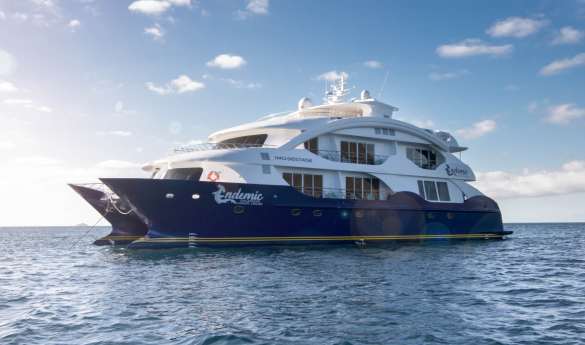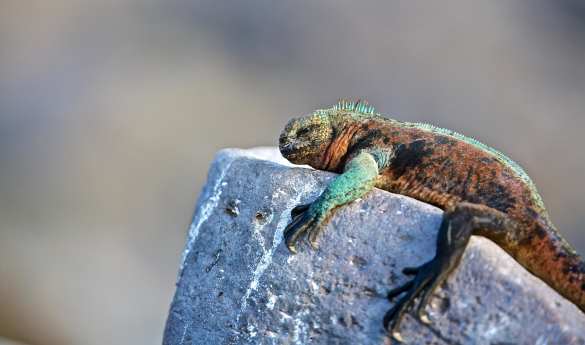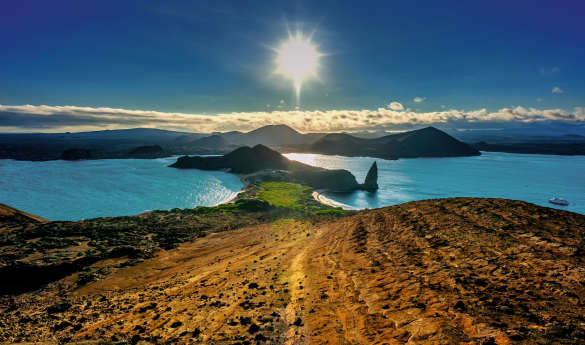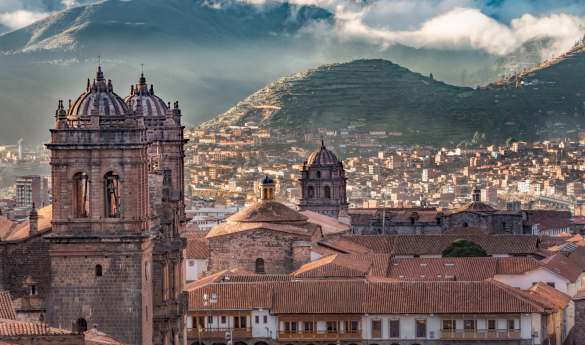Wildlife 101: What Are the Best Birds to See in the Galapagos?
Whether you’re on a romantic honeymoon getaway or a family expedition, seeing the bird life in the Galapagos is a must for any itinerary. But with so many species and islands, where do you start?
01 June 2023

The Galapagos Islands are famous for their exquisite bird species, many of which are found nowhere else in the world. Thanks to a lack of predators and the island’s unusual ecosystem, birds have been able to evolve and thrive in a way that is completely unique to the Galapagos. They seem almost fantastical and mystical, and even people who aren’t keen ornithologists will be captivated by their looks and behaviour.
Up there with the most distinctive of the Galapagos Island birds is the blue-footed booby, which (along with its fabulous name) is known for its bright blue feet and courtship dance. Then there are Darwin's finches, 14 species of closely related small birds famous for their role in his theory of evolution. Among them is the mangrove finch, with a population of only around 100 remaining in the wild, it is the rarest bird in the Galapagos Islands. Meanwhile, seeing the largest bird, the waved albatross, perform its incredible bill clacking, head shaking, and wing flapping mating dance is a sight that the whole family will love.
Each bird species has developed adaptations and characteristics that have allowed it to flourish in this isolated ecosystem. Read on to discover more fascinating tales of our favourite feathered friends
What Kind of Birds Live on the Galapagos?
Galapagos Island birds can be divided into two broad categories: land birds and sea birds.
Land birds are resilient animals. They have evolved to survive the harsh environment, where food and water can be scarce, by growing long beaks to peck insects between tiny cracks or break open nuts and seeds efficiently. Land birds include:
- Finches
- Mockingbirds
- Doves
- Hawks
- Owls
The second type are sea birds, which spend most of their lives in the ocean, coming back to the islands to breed and rest. You’ll spot them ducking and diving or bobbing on the water waiting for their fishy lunch. These include:
- Boobies
- Frigatebirds
- Pelicans
- Cormorants
- Albatrosses
Sea birds also include the two flightless birds, which are endemic to the islands – flightless cormorants and Galapagos penguins.
Both land birds and sea birds play a crucial role in the ecosystem of the Galapagos Islands. They are important pollinators, seed dispersers, predators, and scavengers, and their interactions with other species help to maintain the delicate balance of the islands’ biome.
Read about ecotourism in the Galapagos Islands.
Popular Birds to See on the Galapagos Islands
The Galapagos Islands are a birdwatcher's dream destination, but for less avid twitchers it is still captivating to see the colours, dances, and quirky behaviours of the birds in the Galapagos Islands. Here are some of our favourites to look out for.
1. Blue-footed Booby

- Where it can be found: North Seymour, Española, Fernandina, Floreana, Isabela, Pinzon, and Santa Cruz
- Size: height: 81-85cm, weight: 1.5kg, wingspan: 1.5m
- Diet: Small fish such as anchovies and sardines
- Conservation status: Least concern
This iconic seabird is known for its bright blue feet, which have developed due to a specific type of algae in its diet. Aside from their colour, they’re known for their enthusiastic attempts at courtship, which take place between June and August. Families will love to see the birds show off their beautiful feet by doing the ‘booby two-step´ before they bow their heads and offer their betrothed a stick or stone in an attempt to woo her. There are also Red-footed boobies and Nazca boobies found amongst the Galapagos birds too. They all take their name from the Spanish word ‘bobo,’ which means clown, due to their clumsy walk!
2. Waved Albatross

- Where it can be found: Española
- Size: height: 80-93cm, weight: 3-4kg, wingspan: 2.2-2.5m
- Diet: Fish, squid, krill, crabs, lobsters, shrimp, and other crustaceans
- Conservation status: Critically endangered
The largest bird in the Galapagos, the waved albatross is also known for its distinctive mating dance. He points his beak in the air and nods his head to the floor, like a bow, before circling the female, flapping his wings, and honking. Then he presents her with a stone or stick as a gift, at which point she may respond with her own dance. It’s magnificent to see. Make sure your Galapagos cruise takes you to the island of Española, as this is the only place in the world where the waved albatross can be seen during the breeding season.
3. Galapagos Penguin

- Where it can be found: They are found mainly on Isabela and Fernandina islands, but they can also be seen on Floreana, Santiago and Bartolome. People often swim with Galapagos penguins around Pinnacle Rock on Bartolome.
- Size: height: 49-55cm, weight: 2.5kg
- Diet: Cold-water schooling fish, such as anchovies, sardines, and mullet
- Conservation status: Endangered
The only penguin species found north of the equator; Galapagos penguins are small but mighty. They have adapted to the warm climate and learnt to hunt alone rather than in packs, scooping up small fish quickly and swallowing them whole. These nifty Galapagos birds can reach speeds of up to 35 km per hour when searching for food. Not only this, but they are quite simply one of the most popular animals in the world. These adorable birds are hopeless romantics, beautiful to look at and make everyone smile as they waddle around in groups. If you’re planning a family holiday to the Galapagos, penguins are a must-see for the kids.
4. Galapagos Hawk

- Where it can be found: Isabela and Fernandina
- Size: height: 56cm, weight: 650-850g, wingspan: 120cm
- Diet: Invertebrates such as giant centipedes and locusts, but also occasionally snakes, rodents, lizards, young iguanas, turtle hatchlings and other birds.
- Conservation status: Vulnerable
Seen perched on rocks or soaring overhead, this is the top predator on the Galapagos and it can be pretty vicious. Galapagos hawks have been seen dropping rocks onto the eggs of seabirds to crack them open and get the yolk inside. This behaviour is not seen in other hawks and highlights how resourceful the birds in the Galapagos have become.
These fascinating creatures are vital to the ecosystem of the islands, controlling the population of other prey. However, there are only thought to be about 150 breeding pairs left and seeing one is a thrilling experience that children and adults alike will love. Despite being predators, the birds aren’t aggressive towards humans – unless you disturb their young – so you may have an opportunity to get close to them.
5. Darwin's Finches

- Where it can be found: The finches can be found on most of the main islands like Isabela, Genovesa, Floreana, Fernandina and Santa Cruz, although some, like the sharp-beaked ground finch, can only be found in the more remote islands of Wolf and Darwin.
- Size: height: 10 and 20cm, weight: varies, wingspan: varies
- Diet: This varies depending on the flora and fauna found on the islands they live on. They tend to eat small insects, beetle larvae and vegetation.
- Conservation status: Most are least concern, however, the mangrove finch is critically endangered and the large tree finch, woodpecker finch and green warbler finch are vulnerable.
It was thanks to the sizes and shapes of these animals’ beaks that Darwin developed the theory of evolution. He observed that while the 14 closely related Galapagos birds were all similar in shape and size, their beaks were unique depending on which island they lived on. He believed they had adapted to allow them to feed on different foods and so began his famous theory. The finches have become a symbol of evolution and are still studied today, making them a fascinating addition to your Galapagos wildlife sightings. Kids will delight in seeing the tiny birds dance in the air and keen scientists will get a buzz seeing evolutionary theory come to life.
Among the famous finches are the:
- Mangrove finch
- Small, medium, and large tree finches
- Small, medium, and large ground finches
- Green and grey warbler finches
- Woodpecker finch
- Large cactus finch
- Common cactus finch
- Sharp-beaked ground finch (also known as the vampire bird of the Galapagos islands, due to the way it pecks at the feathers of Nazca boobies until they bleed and then sucks its blood).
6. Lava Heron

- Where it can be found: Along the shoreline of all the islands.
- Size: height: 35cm tall, weight: 2.1kgs, wingspan: 63cm
- Diet: Small fish and crabs. Have been recorded to catch crabs at a fast rate of two to three per minute.
- Conservation status: Least concern
These small herons live and nest along the lava rock coastlines, saltwater lagoons, and mangrove forests and are camouflaged against the grey basalt rocks on which they inhabit. During the breeding season, their legs change from an uninteresting grey to a vibrant orange, and the bill of the male turns from grey to black. The birds have a clever hunting technique where they use their wings to create shade over the water, this attracts fish to the surface where they can be easily caught.
7. Magnificent Frigate

- Where it can be found: Santa Fe, North Seymour, Floreana, San Cristobal and Genovesa
- Size: height: up to 1.1m tall, weight: 1.1-1.4kg, wingspan: 215-240cm
- Diet: Fish and small crustaceans as well as newly hatched green turtles. They also chase other birds on the Galapagos Islands, such as tropicbirds or boobies and force them to regurgitate their recently caught food by grabbing their tail feathers and shaking them, then catching the regurgitated food before it enters the sea!
- Conservation status: Least concern
Also known as pirate birds, due to their unorthodox way of hunting (see above), or the condor of the oceans, these birds can fly for days and nights due to their exceptionally large wingspan. Their body shape also gives them amazing manoeuvrability and visitors become almost hypnotised by the way this bird glides through the sky. Capturing the bold red chest of a magnificent frigate will be a thrill for wildlife photographers.
8. Flightless Cormorant

- Where it can be found: Isabela and Fernandina
- Size: height: 90-100cm tall, weight: 3-5kg
- Diet: Eels and octopus, which they reach by diving deep onto the ocean floor.
- Conservation status: Vulnerable
As their name suggests, these birds cannot fly. Natural selection led to the cormorants no longer having wings that worked. They had very few land predators, and the birds that were better swimmers were more successful at passing on their genes. They are also the heaviest birds in the Galapagos. Now they use their stunted wings to balance as they hop over rocks from coast to coast. Their mating dance is another treat for visitors to the Galapagos as it sees the couples intertwine their necks whilst twirling in a tight circle.
Start Planning Your Trip Today
Whether or not you have a passion for birdwatching, the 50 or so species you will find in the Galapagos Islands will provide you with hours of entertainment and stunning photographs to take home. Most of our Galapagos cruises will take you to the islands that these birds inhabit, so start planning by getting in touch with one of Scott Dunn’s travel specialists.
Why Scott Dunn?
Unique to You

- We listen to your travel goals and craft unique trips that are bespoke to you.
- We’re with you every step of your life’s travel journey, from honeymoons to family trips and beyond.
Seamless Service

- Global offices in the UK, US, and Singapore for 24/7 seamless service.
- We offer flexibility if your plans change so you can book with confidence and peace of mind.
Carefully Curated Collection

- We’ve curated an elevated collection of accommodation, experiences, and guides.
- Committed to fostering close global relationships to continue bringing you unique experiences.
Luxury in Every Sense

- We deliver a sense of luxury that matters most to you.
- Awarded Condé Nast Traveller’s Top Travel Specialists in the World 12 years in a row.







